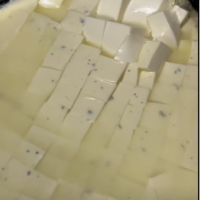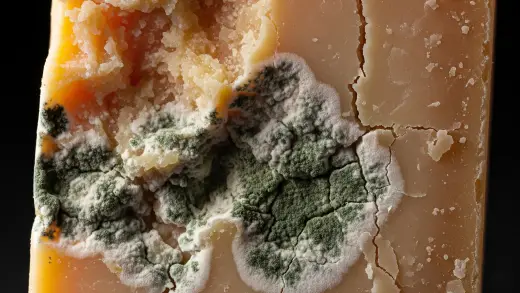Soft cheeses left unrefrigerated for over two hours (or one hour if above 90°F/32°C) should be discarded due to the risk of bacterial growth and foodborne illness (USDA).
Hard cheeses are generally safer for short periods (within 4 hours, but quality declines). Always check for spoilage: unpleasant smell, slimy surface, mold, or changes in color/texture.
Ever peeked in the pantry and spotted a forgotten block of cheddar, a lonely slice of Swiss, or maybe even a creamy wedge of brie sitting out? Uh oh! That little dairy delight might be in a bit of a pickle.
We all know that milk and other fresh foods need to stay cool in the fridge, but what about cheese? Is it the same story?
Leaving cheese out at room temperature can bring up some worries. Will it go bad? Could it make you sick? These are good questions!
That’s exactly what we’re going to explore in this guide. Think of it as your friendly handbook to understanding what happens when cheese isn’t chilled.
We’ll dive into how long different kinds of cheese can safely sit out and what to look for to make sure your cheesy treat is still yummy and won’t cause any tummy troubles. So, let’s unwrap the mystery of unrefrigerated cheese together!

Can You Eat Unrefrigerated Cheese?
You can eat unrefrigerated cheese, but how long it remains safe and palatable depends on several factors, primarily the type of cheese.
Here’s a general guideline:
Hard cheeses like cheddar, Parmesan, Gouda, and Swiss have lower moisture content, making them less prone to bacterial growth.
They can generally sit out at room temperature for up to 4 hours without a significant risk of foodborne illness, according to the U.S. Department of Health.
Some sources even suggest they can be left out for up to 8 hours, or even longer if they have a natural rind or are waxed.
However, after a few hours, the quality and taste may start to change as the fat begins to separate, leading to a greasy surface and potential drying.
Semi-hard cheeses such as provolone, Monterey Jack, and some cheddars can also be left out for up to 4 hours.
Soft cheeses with high moisture content, such as Brie, Camembert, and fresh mozzarella, are more perishable. They should not be left at room temperature for more than 2 hours.
Fresh cheeses like cottage cheese, cream cheese, ricotta, and Queso Fresco are the most perishable and should not be left unrefrigerated for more than 1 hour, especially if the room temperature is above 90°F (32°C).
It’s often recommended to bring cheese to room temperature (about 20-30 minutes for most, up to an hour for harder cheeses) before serving to enhance its flavor and texture. This time should be factored into the total time the cheese is unrefrigerated.
In summary, while some harder cheeses are more forgiving, it’s generally best to refrigerate cheese and not leave it out for more than a couple of hours to ensure safety and quality.
If you accidentally leave cheese out overnight, it’s generally safer to discard soft cheeses, while hard cheeses might still be acceptable if they show no signs of spoilage.
The Golden Rule: Two-Hour Limit
Imagine a timer ticking for your cheese. The United States Department of Agriculture (USDA), which knows a lot about keeping our food safe, says that perishable foods, and that definitely includes yummy, soft cheeses, shouldn’t be left out on the counter for more than two hours.
Think of it like this: after two hours, tiny little invisible bad guys called bacteria can start to multiply and make your cheese unsafe to eat.
Now, if it’s a super hot day, like over 90°F (that’s about 32°C), that two-hour timer speeds up! In that kind of heat, you only have about one hour before those bacteria can cause trouble.
So, on warm days, it’s extra important to get your cheese back in the fridge quickly!
Understanding Different Types of Cheese
Did you know that not all cheeses are created equal when it comes to how long they can hang out at room temperature? The kind of cheese makes a big difference.
Hard Cheeses
Think of cheeses like cheddar, that firm block you might slice for a sandwich, or Parmesan, the hard, salty one you sprinkle on pasta.
Gouda and Swiss are also in this group. These cheeses don’t have a lot of water inside them, which makes it harder for those bad bacteria to grow.
So, if a hard cheese is left out for a little while (some say up to about 4 hours, but the taste might not be the best), it’s generally safer than softer cheeses.
But keep a close eye on it! How do you know if a hard cheese has gone bad? Look for a weird smell, a slimy surface, dark spots, if it’s super dry or has cracks, or if you see any fuzzy mold.
Soft Cheeses
These are the creamy, spreadable kinds like Brie, Camembert (that soft cheese in a round), Mozzarella (especially the fresh, watery kind), cream cheese you spread on bagels, cottage cheese with the little curds, and ricotta.
These cheeses have lots of moisture, which is like a playground for bacteria! Because of this, you should toss soft cheeses if they’ve been out for more than two hours. What are the danger signs?
A slimy feel, if the color has turned yellowish, if you see any mold, or if it smells sour or even like ammonia. Yuck!
Processed Cheeses
You know those individual slices of American cheese? These are often made with special ingredients called preservatives that help them last longer.
This might make them a little more okay with being out for a bit, but to be super safe and to keep them tasting good, you should still stick to that two-hour rule.
What Happens When Cheese is Left Out?
Imagine a warm, cozy place with plenty of food – that’s what room temperature can be like for tiny bacteria! When cheese sits out, these bacteria can start munching and multiplying really fast.
This can lead to foodborne illnesses, which can make you feel really sick with things like stomach aches or even worse.
Besides the safety part, leaving cheese out also messes with its quality. It might not taste as good, the flavor could change, and the texture can get weird. You might see it get oily or start to dry out.
So, even if it doesn’t make you sick, it might not be a very pleasant snack anymore.
How to Identify Spoiled Cheese?
It’s like being a cheese detective! Here are some clues to look for to see if your cheese has gone bad:
General Signs (for any cheese)
If it has a strange, bad smell that makes you go “eww,” or if you see any fuzzy mold growing on it (think of the green or white fuzz you sometimes see on old bread). Also, watch out if the color looks different than it should.
Hard Cheese Clues
Feel it – is it slimy? See any dark spots that weren’t there before? Is it super dry or cracked?
Now, here’s a tricky thing: sometimes on hard cheeses, if there’s just a tiny spot of mold, you can cut away at least one inch around and below the mold spot and the rest might be okay to eat. But if you’re not sure, it’s always best to be safe and throw it away.
Soft Cheese Clues
If it feels slimy, if the color has turned yellowish, or if it smells sour or like ammonia, don’t even taste it! Toss it right away.
What to Do If You’ve Left Cheese Out?
So, What to Do if you’ve left cheese out? It happens to the best of us. Here’s what to do depending on how long your cheese has been out:
Within Two Hours
If you just realized you forgot the cheese, and it’s been less than two hours, it’s generally safe to pop it back in the fridge. However, keep in mind that the taste and texture might not be quite as perfect as before.
Between Two and Four Hours (Hard Cheeses)
If it’s a hard cheese and it’s been out for a little longer, take a good look and sniff. If you don’t see any of those spoilage signs we talked about, you can rewrap it tightly and put it in the fridge. But try to eat it sooner rather than later.
Over Two Hours (Soft Cheeses)
If your soft cheese has been out for more than two hours, it’s best to say goodbye and throw it away. It’s not worth the risk of getting sick.
Over Four Hours (Any Cheese)
For any type of cheese that’s been sitting out for more than four hours, it’s generally recommended to toss it, even if it looks okay. Those sneaky bacteria might be there even if you can’t see them.
Tips for Serving and Storing Cheese
Here are some smart ways to handle your cheese:
Serving
When you’re putting out cheese, only take out as much as you think people will eat. If you’re having a cheese board, keep the extra cheese in the fridge and add more as needed.
On a hot day, you could even think about using a chilled plate to keep the cheese cooler for longer.
Storing
The way you wrap your cheese matters! Parchment paper, cheesecloth, or special cheese bags are better than plastic wrap that’s too tight, as they let the cheese breathe a little.
Store your cheese in the part of your fridge that stays the most steady in temperature, like the vegetable or egg drawer. And keep it away from strong-smelling foods, because cheese can actually soak up those smells!
Exceptions and Considerations
You might have seen some cheese in the store that doesn’t need to be refrigerated until you open it, like some processed cheese in a can. These are made in a special way to be shelf-stable.
Also, think way back before everyone had refrigerators! People used to preserve cheese using things like aging it for a long time, adding lots of salt, and keeping it in cool, specific environments like caves.
These traditional methods helped keep the cheese from spoiling without a fridge.
Conclusion
The big takeaway here is: when in doubt, throw it out! Especially with soft cheeses, it’s always best to follow that two-hour rule to stay safe.
While hard cheeses are a little more forgiving, leaving them out for too long can still mess with how good they taste.
So, let’s keep our cheese happy and healthy by keeping it properly chilled in the fridge! That way, we can all enjoy those delicious cheesy bites without any worries.















